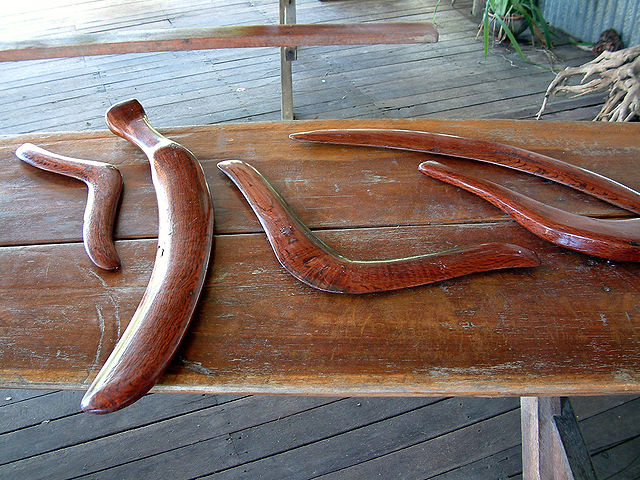
Why does a boomerang come back? One wing travels faster than the other which causes it to fly in a circular path. However, not all boomerangs are designed to come back and the one most people are probably thinking of is the modern version of the boomerang. The boomerang was a weapon used by the Aboriginal people in Australia and they used different types for different jobs. The general boomerangs they used were mostly not meant to come back.
The Aboriginals have been living in Australia since about 65,000 years ago and cave art from 50,000 years ago shows Aboriginal people throwing boomerangs at kangaroos. This cave art is in the Kimberly region and is part of some of the oldest cave art in the world. There is also cave art depicting people in Papua New Guinea using boomerangs, which shows that the cultures were connected. This is not surprising because Papua New Guinea was connected to Australia until the end of the last ice age, about 8,000 years ago, when sea levels rose and separated them. The oldest actual boomerang that has been found is 20,000 years old and it was found in a peat bog in Poland. Throwing sticks have been found on most continents because they are incredibly powerful.
Aboriginal hunting boomerangs were made of a slightly curved piece of wood. They looked a little like a scimitar. They were larger at one end than the other and were gently curved. The thinner end was the throwing end. They were usually about 80 cm long, but some versions were as long as 2 meters. They were cut with an aerodynamic edge so that when they were thrown they spun like a propeller and could cover great distances. They were accurate at over 150 meters. They spun with such force that they could easily break the legs of an animal, or kill it outright. Early people came up with the design through trial and error. They threw sticks to start with but slowly realized that a curved stick would fly further and more accurately. The Aboriginals often threw their boomerangs into flocks of birds to bring some of them down. The boomerang was used for hunting and it was a weapon of war as well. They also used them to dig for water, start fires, cut open animals, as musical instruments, and a host of other tasks. The Aboriginal Australians did also use boomerangs that come back. They used them to scare birds into the air where they could be brought down with a boomerang that didn’t come back.
So, how does a boomerang fly? Boomerangs are different to other objects that are thrown or fired because they are meant to fly parallel to the ground. A spear, or a canonball, has to be supplied with enough energy and speed to carry it to its direction and it will fly in a curved trajectory, getting higher until it peaks and then falling back down towards the target. This is called a ballistic trajectory. If a canonball was fired parallel with the ground, gravity would pull it down and it would impact the ground pretty quickly. Boomerangs don’t come down because as long as they keep spinning they will keep flying. How? The boomerang is shaped like a wing, which is how it gets lift when it is thrown. As long as it is spinning, air passes over the wing and creates lift. It flies parallel to the ground because a boomerang that doesn’t return has one longer side. As the boomerang spins through the air, lift pushes it up at the front, but the longer side produces a slight drag. The two forces cancel each other out and the boomerang flies straight.
So, why does a returning boomerang come back? It is the same principle that a gyroscope works and is called gyroscopic precession. The two sides of the boomerang are the same length and the wing produces lift at the front, then spins to the back and produces lift again. Both sides can’t move in the same direction so these two forces cancel each other out and the boomerang flies straight. It is the same as when you hang a spinning wheel tied with a rope on its right axle only. It doesn’t fall over because the part of the wheel at the top wants to fall to the left, but when that same part of the wheel rotates to the bottom, it still wants to fall to the left, but if the top and the bottom are both trying to fall to the left, the wheel doesn’t move. However, when this happens, the spinning wheel produces torque out from the point where it is tied to the rope and the wheel rotates. The same happens with the boomerang. The spinning wings produce torque out to the side and if the boomerang is thrown properly it will fly in a circle, coming back to where it started. The boomerang has to be thrown vertically because if it is thrown horizontally, the torque will make it fly up in a steep arc. And this is what I learned today.
Image CC BY-SA 1.0, https://commons.wikimedia.org/w/index.php?curid=94181
Sources
https://www.streetscience.com.au/why-do-boomerangs-come-back/
https://en.wikipedia.org/wiki/Precession#Torque-induced
https://futurism.com/science-explained-boomerangs-come-back
https://australian.museum/learn/cultures/atsi-collection/boomerangs/why-a-boomerang-flies/
https://www.throwsticks.com/history-science
http://www.culturequest.us/aboriginal_tools/boomerang.htm
https://www.aaia.com.au/hunting-boomerang/
https://en.wikipedia.org/wiki/Boomerang
